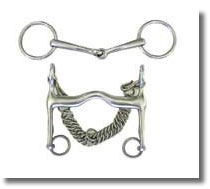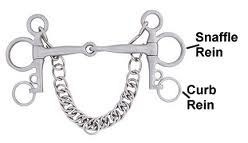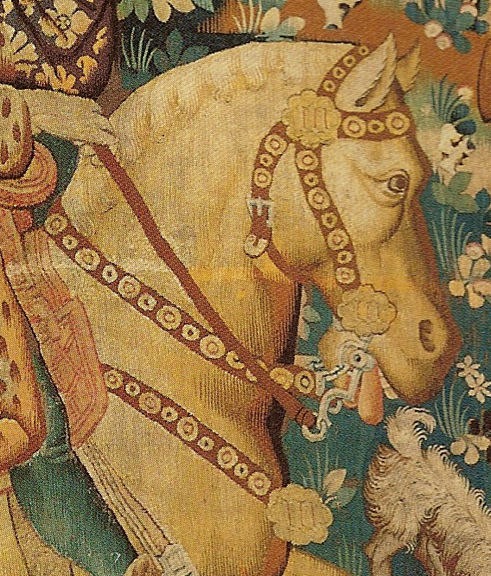Horsemanship Level 3: Bits
As well as knowing your own horse's tack, at level 3 you will need to:
5. Identify common bits and their uses
You only need to know common English bits including snaffles, curbs and pelhams. However, it's good to recognize some Western bits as well, simply for familiarity.
Snaffles
Our school horses generally wear snaffle bits. Any bit where the cheekpiece and rein attach to the same ring is a snaffle, regardless of the type of mouthpiece or shape of the rings. A bit that has separate rings for the cheekpieces and reins is never a snaffle, regardless of the the mouthpiece.
This is the gentlest type of bit, especially with a thick mouthpiece. There is action on the horse's tongue, lips and bars of the mouth, but no leverage action on the poll or chin. When the rings are fixed, as with the egg butt, D-ring or full cheek, there is more action on the bars of the mouth than with a loose ring.
The types of snaffle cheekpieces you should be familiar with are:
1. Loose ring
2. Egg butt
3. Full cheek
4. D-ring
As well you should be able to recognize the following mouthpieces:
1. Single jointed
2. French link
3. Mullen mouth
4. Slow twist
The mouthpiece affects the severity of the bit. A mullen mouth or straight bar is the gentlest type. A single joint can produce a nutcracker effect and sometime put pressure on the palate. A double joint, such as a French link provides more even tongue pressure. Twisted wire is extremely severe and should not be used.
Curb Bits

A curb bit has at least two different rings, one for the cheekpiece and one for the rein, as well as a shank, which provides leverage on the poll, and puts pressure on the chin groove via a curb chain. Classically a curb bit is used with a double bridle, in conjunction with a small snaffle known as a bridoon. The curb provides extra finesse and is often used in dressage. However the main contact always comes from the bridoon (snaffle). In Western riding a curb bit is often used on its own with a loose rein.
Pelhams

A pelham combines the leverage of a curb with the direct action of a snaffle with a single bit. It is traditionally used with two sets of reins, but a converter can be used to connect the rings to a single rein, with some loss to the advantages of both. The kimberwick or kimblewick is a type of pelham with a curb chain, fixed rein settings but no shanks.
Historical Bits
Bits used in the past varied from simple snaffles to complex and severe curb bits. The long-shanked curbs used by most mediaeval knights may have been useful for stopping on a dime, but they can be extremely harsh in the hands of an insensitive or inexperienced rider and we avoid them in our program for that reason.
Coming up in Cavaliere
Cavaliere Classes
Sundays 19 October, 9 November, 1- 4:30pm
Sunday 26 October, 3 – 6:30pm
cost: $60 or one flex-pack credit per class
Cavaliere Classes have moved back to Sunday afternoons. Note that on Sunday October 26th class is from 3:00 to 6:30pm instead of the usual 1:00 – 4:30pm.
Apprentices Wanted
Looking to earn some horseback time? Trade barn and program assistance work for riding hours or discounts on Cavaliere Program courses. Email jen@academieduello.com for details.
